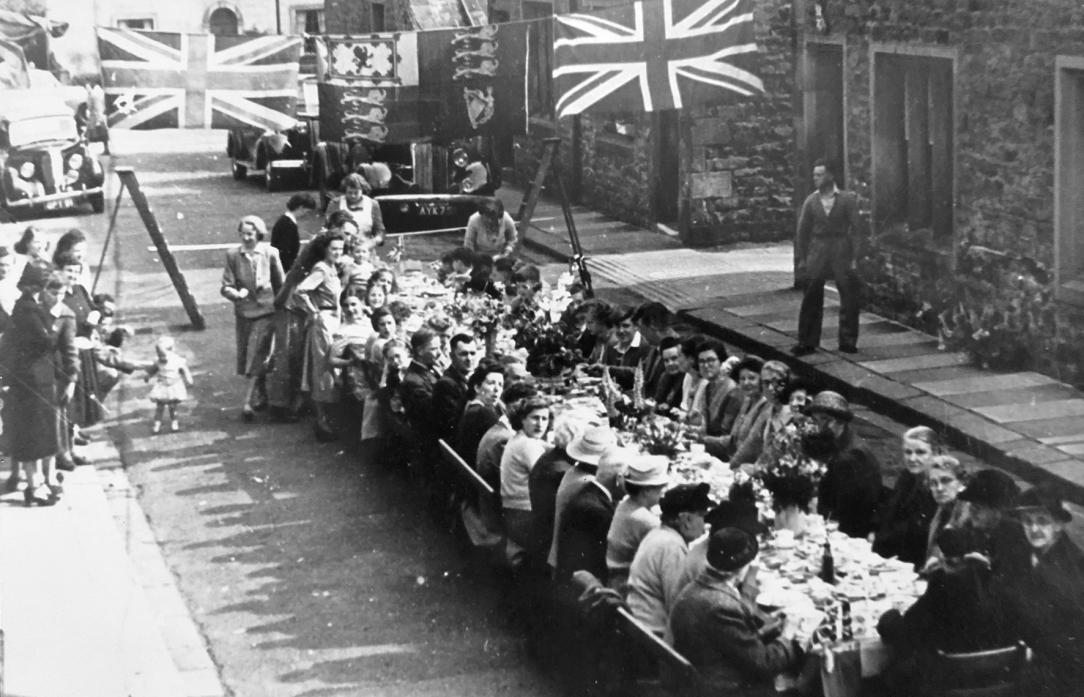
Recent events to mark the 75th anniversary of VE Day prompted Peter Dixon to recall a 1998 production by The Castle Players, directed by Simon Pell. Much Ado About Northing was set on VE Day, May 8, 1945, and as part of the programme which Peter put together for the show, local historian Alan Wilkinson contributed an article about life in Barnard Castle at the time. It seemed to be an appropriate time to reproduce the article, illustrated by photographs from the Parkin Raine Collection.
WHEN, in 1945, peace came at the end of the Second World War, Barnard Castle celebrated twice.
First, there was the spontaneous and “unofficial” jollifications which included several street parties; long tables were erected in the street, on which residents spread as sumptuous a tea as the restrictions of the time allowed. Flowers and flags, especially the national one, lent further colour to the scene.
The official thanksgiving, tempered by the sombre thought that 52 men who had gone to war would never return to their home town, were held in 1946.
There were church services of thanksgiving for peace and for victory, and Barnard Castle celebrated with an immensely successful version of its traditional Meet, known that year as Victory Meet and held, as usual, at Whitsuntide.
The origins of the carnival had been the meeting of cycling clubs and, though not so prominent as in earlier years, cycling was still an important feature.
A thousand cyclists came to the Victory Meet; 8,000 people watched the procession on Whit Monday and 3,000 people attended a gymkhana on the upper Demesnes.
The day ended with a grand dance at The Witham Hall and when the president of the Meet, Cllr G A (Tommy) Carter arrived, the music stopped and dancers formed an avenue through which he walked to the stage while the whole assembly, accompanied by the band, sang He's A Jolly Good Fellow.
It was a triumphant peace-time revival of the Meet and it demonstrated the continuation of the spirit of co-operation that had characterised civilian life in wartime.
There had been many examples of this spirit. When 400 evacuees arrived in Barnard Castle in one day at the very start of the war, every child was accommodated with temporary foster parents by nightfall.
In the first year of the war, 140 inhabitants were trained in various aspects of civil defence and eventually 1,000 volunteers were involved in air raid precautions and other activities on the Home Front.
These included wardens, special constables, ambulance and rescue teams, the auxiliary fire service and the Women's Voluntary Service.
Barnard Castle was also an important military centre. Thousands of soldiers were billeted in the town and on six camps which were built within three miles and in the Teesdale countryside, the men were trained for combat.
As more local men joined the fighting forces, women and older men took over their civilian occupations, worked in munition factories and joined in other wartime activities.
Their ages ranged from schoolboys with bicycles, who became air raid messengers, to veterans of the Great War, many of whom joined the Local Defence Volunteers, established in 1940, at first without weapons or any uniforms other than armbands, but later known as the Home Guard and issued with military equipment and full battle dress. The nation really felt united and when peace came in Europe in May 1945, and in the Far East in August, men returning from the war quickly resumed their peace-time occupations and happily took up their former leisure pursuits.





